Belkin F5D7231P High-Speed Mode Wireless G Router w/ Print Server User Manual P74606 F5D7231 4P man indd
Belkin International, Inc. High-Speed Mode Wireless G Router w/ Print Server P74606 F5D7231 4P man indd
Belkin >
Contents
Users Manual Part 8
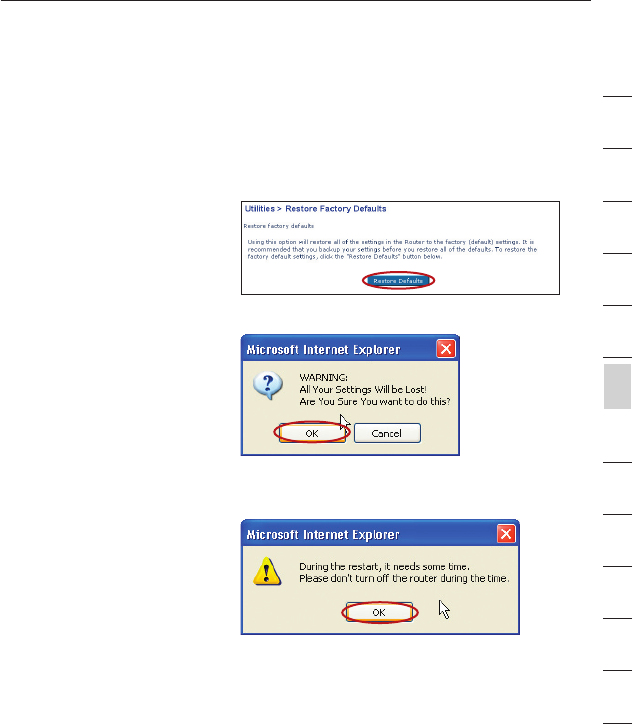
88
Using the Web-Based Advanced User Interface
Using the Web-Based Advanced User Interface
89
section
2
1
3
4
5
6
7
8
9
10
11
12
13
Restoring Factory Default Settings
Using this option will restore all of the settings in the Router to the
factory (default) settings. It is recommended that you back up your
settings before you restore all of the defaults.
1. Click the “Restore
Defaults” button.
2. The following message
will appear. Click “OK”.
3. The following message
will appear. Restoring
the defaults includes
restarting the Router.
It can take up to 60
seconds. It is important
not to turn the power
to the Router off during
the restart.
4. A 60-second countdown will appear on the screen. When the
countdown reaches zero, the Router’s defaults will be restored.
The Router home page should appear automatically. If it does
not, type in the Router’s address (default = 192.168.2.1) into the
navigation bar of your browser.
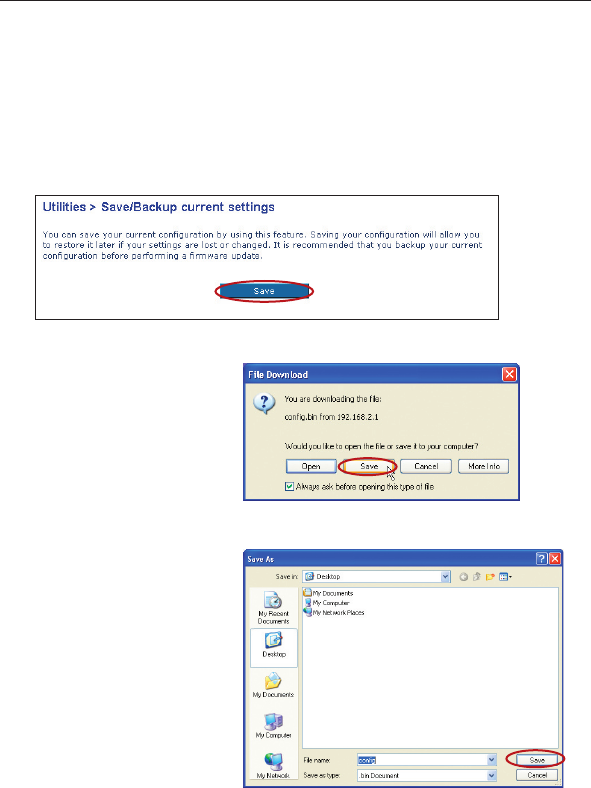
90
Using the Web-Based Advanced User Interface
Using the Web-Based Advanced User Interface
91
section
2
1
3
4
5
6
7
8
9
10
11
12
13
Saving a Current Configuration
You can save your current configuration by using this feature. Saving
your configuration will allow you to restore it later if your settings are
lost or changed. It is recommended that you back up your current
configuration before performing a firmware update.
1. Click “Save”. A window
called “File Download”
will open. Click “Save”.
2. A window will open
that allows you to
select the location
where you want to
save the configuration
file. Select a location.
You can name the file
anything you want, or
use the default name
“Config”. Be sure to
name the file so you
can locate it yourself
later. When you have
selected the location
and name of the file,
click “Save”.
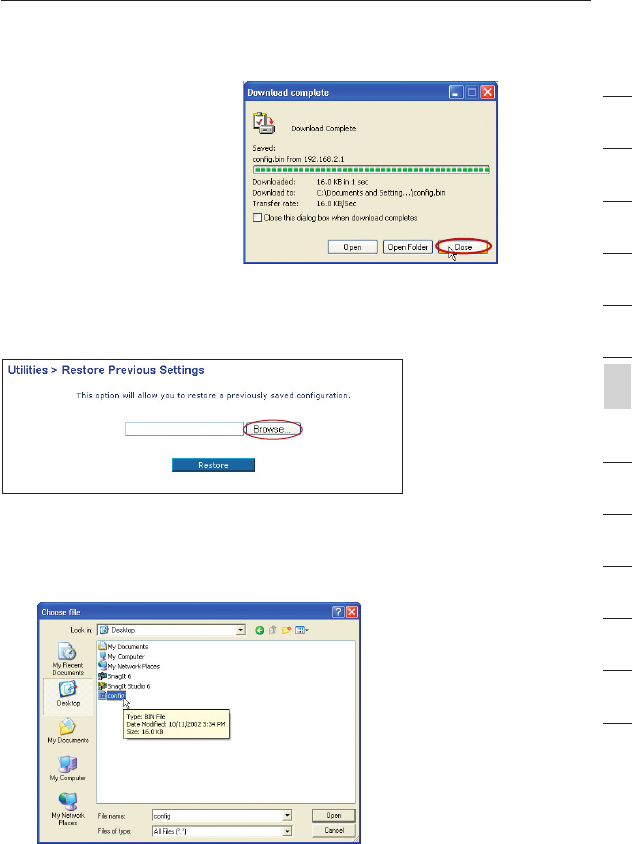
90
Using the Web-Based Advanced User Interface
Using the Web-Based Advanced User Interface
91
section
2
1
3
4
5
6
7
8
9
10
11
12
13
3. When the save is
complete, you will see
the following window.
Click “Close”.
The configuration is
now saved.
Restoring a Previous Configuration
This option will allow you to restore a previously saved configuration.
1. Click “Browse”. A window will open that allows you to select the
location of the configuration file. All configuration files end with
a “.bin”. Locate the configuration file you want to restore and
double-click on it.
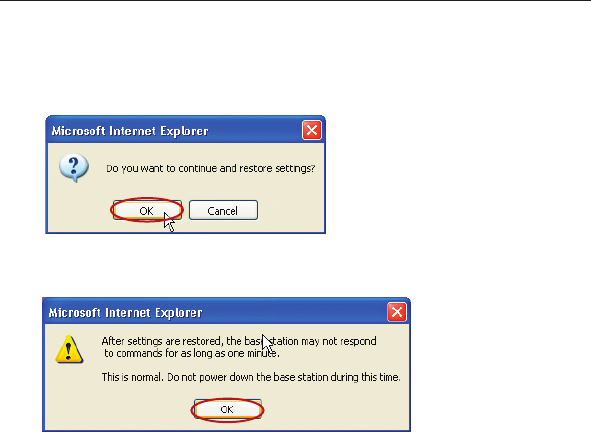
92
Using the Web-Based Advanced User Interface
Using the Web-Based Advanced User Interface
93
section
2
1
3
4
5
6
7
8
9
10
11
12
13
2. You will be asked if you want to continue. Click “OK”.
3. A reminder window will appear. It will take up to 60 seconds for
the configuration restoration to complete. Click “OK”.
4. A 60-second countdown will appear on the screen. When the
countdown reaches zero, the Router’s configuration will be
restored. The Router home page should appear automatically. If
not, type in the Router’s address (default = 192.168.2.1) into the
navigation bar of your browser.
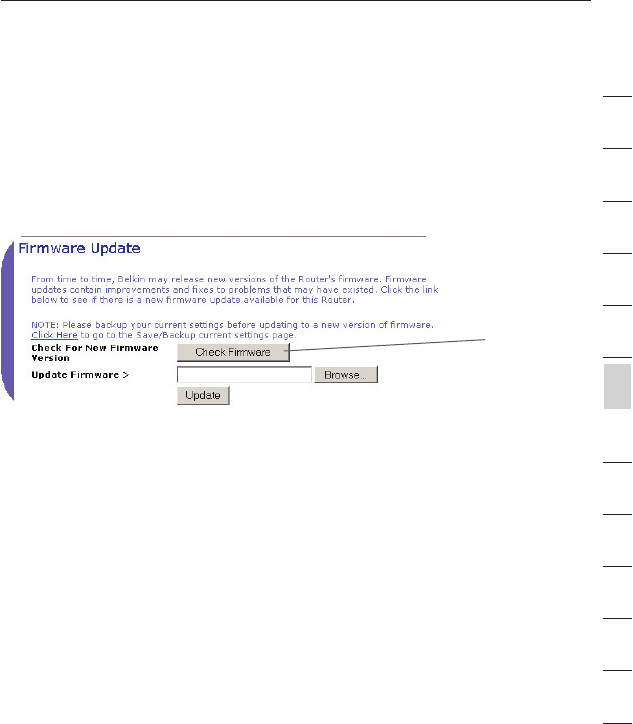
92
Using the Web-Based Advanced User Interface
Using the Web-Based Advanced User Interface
93
section
2
1
3
4
5
6
7
8
9
10
11
12
13
Updating the Firmware
From time to time, Belkin may release new versions of the Router’s
firmware. Firmware updates contain feature improvements and fixes
to problems that may exist. When Belkin releases new firmware,
you can download the firmware from the Belkin update website and
update your Router’s firmware to the latest version.
Checking for a New Version of Firmware
The “Check Firmware” (1) button allows you to instantly check for a
new version of firmware. When you click the button, a new browser
window will appear informing you that either no new firmware is
available or that there is a new version available. If a new version is
available, you will have the option to download it.
(1)
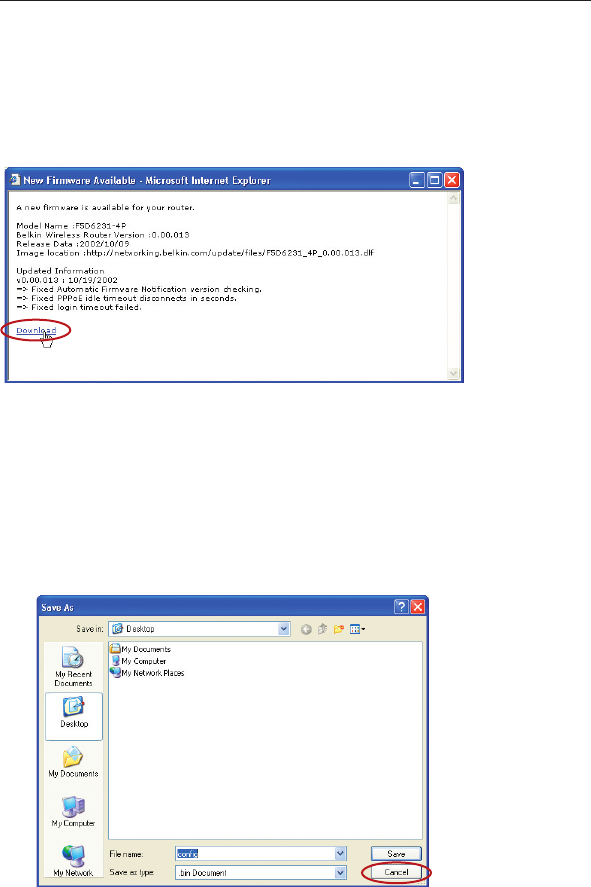
94
Using the Web-Based Advanced User Interface
Using the Web-Based Advanced User Interface
95
section
2
1
3
4
5
6
7
8
9
10
11
12
13
Downloading a New Version of Firmware
If you click the “Check Firmware” button and a new version of
firmware is available, you will see a screen such as the following.
1. To download the new version of firmware, click “Download”.
2. A window will open that allows you to select the location where
you want to save the firmware file. Select a location. You can
name the file anything you want, or use the default name. Be
sure to save the file in a place where you can locate it yourself
later. Note: We suggest saving this to your desktop to locate the
file easily. When you have selected the location, click “Save”.
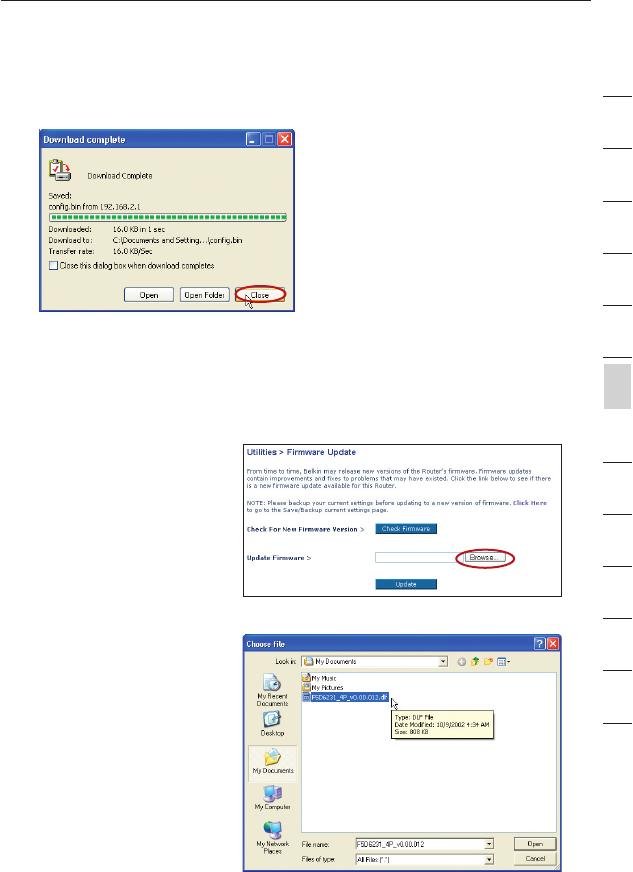
94
Using the Web-Based Advanced User Interface
Using the Web-Based Advanced User Interface
95
section
2
1
3
4
5
6
7
8
9
10
11
12
13
Updating the Router’s Firmware
1. In the “Firmware
Update” page, click
“Browse”. A window
will open that allows
you to select the
location of the firmware
update file. All firmware
files end with a “.dlf”.
2. Browse to the firmware
file you downloaded.
Select the file by
double-clicking on the
file name.
3. When the save is complete, you will see the following window.
Click “Close”.
The download of the firmware is complete. To update the firmware,
follow the next steps in “Updating the Router’s Firmware”.
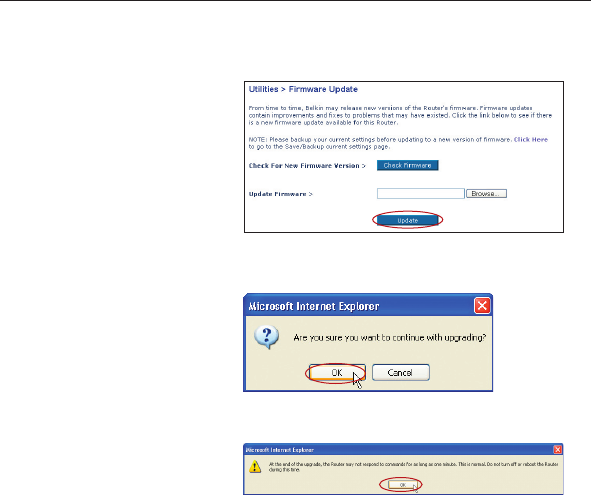
96
Using the Web-Based Advanced User Interface
Using the Web-Based Advanced User Interface
97
section
2
1
3
4
5
6
7
8
9
10
11
12
13
3. The “Update Firmware”
box will now display
the location and name
of the firmware file you
just selected. Click
“Update”.
4. You will be asked if you
are sure you want to
continue. Click “OK”.
5. You will see one more
message. This message
tells you that the Router
may not respond for as
long as one minute as
the firmware is loaded
into the Router and
the Router is rebooted.
Click “OK”.
6. A 60-second countdown will appear on the screen. When the
countdown reaches zero, the Router firmware update will be
complete. The Router home page should appear automatically. If
not, type in the Router’s address (default = 192.168.2.1) into the
navigation bar of your browser.
The firmware update is complete!
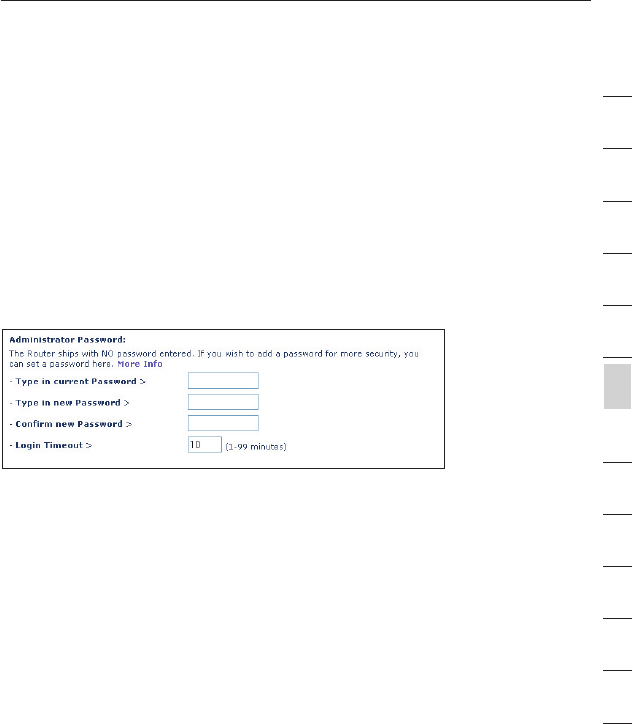
96
Using the Web-Based Advanced User Interface
Using the Web-Based Advanced User Interface
97
section
2
1
3
4
5
6
7
8
9
10
11
12
13
Changing System Settings
The “System Settings” page is where you can enter a new administrator
password, set the time zone, enable remote management, and turn on and
off the NAT function of the Router.
Setting or Changing the Administrator Password
The Router ships with NO password entered. If you wish to add a password
for greater security, you can set a password here. Write down your password
and keep it in a safe place, as you will need it if you need to log into the
Router in the future. It is also recommended that you set a password if you
plan to use the remote management feature of your Router.
Changing the Login Timeout Setting
The login timeout option allows you to set the period of time that you can
be logged into the Router’s advanced setup interface. The timer starts when
there has been no activity. For example, you have made some changes in
the advanced setup interface, then left your computer alone without clicking
“Logout”. Assuming the timeout is set to 10 minutes, then 10 minutes after
you leave, the login session will expire. You will have to login to the Router
again to make any more changes. The login timeout option is for security
purposes and the default is set to 10 minutes.
Note: Only one computer can be logged into the Router’s advanced setup
interface at one time.
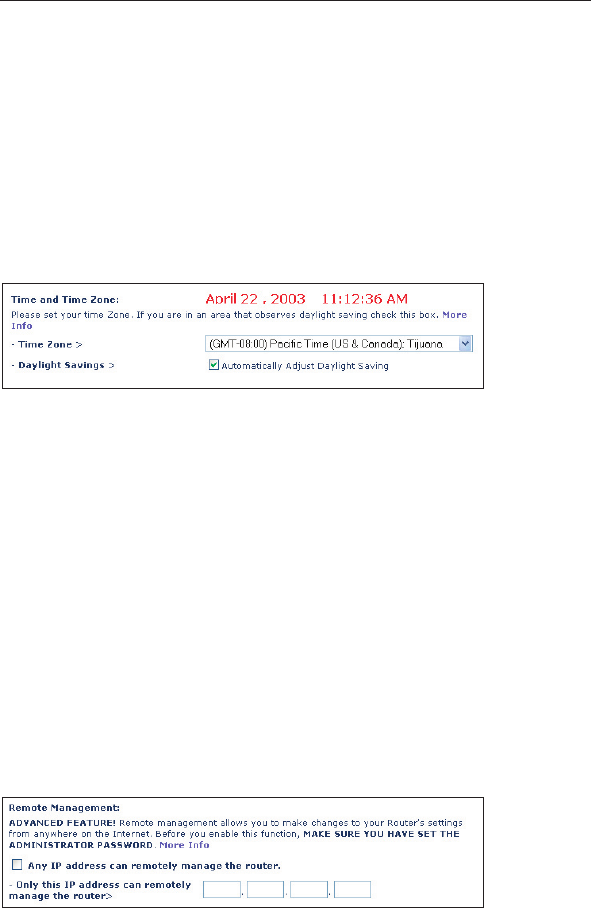
98
Using the Web-Based Advanced User Interface
Using the Web-Based Advanced User Interface
99
section
2
1
3
4
5
6
7
8
9
10
11
12
13
Setting the Time and Time Zone
The Router keeps time by connecting to a Simple Network Time Protocol
(SNTP) server. This allows the Router to synchronize the system clock to the
global Internet. The synchronized clock in the Router is used to record the
security log and control client filtering. Select the time zone that you reside
in. If you reside in an area that observes Daylight Saving, then place a check
mark in the box next to “Enable Daylight Saving”. The system clock may
not update immediately. Allow at least 15 minutes for the Router to contact
the time servers on the Internet and get a response. You cannot set the
clock yourself.
Enabling Remote Management
Before you enable this advanced feature of your Belkin Router, MAKE SURE
YOU HAVE SET THE ADMINISTRATOR PASSWORD. Remote management
allows you to make changes to your Router’s settings from anywhere on the
Internet. There are two methods of remotely managing the Router. The first
is to allow access to the Router from anywhere on the Internet by selecting
“Any IP address can remotely manage the Router”. By typing in your WAN
IP address from any computer on the Internet, you will be presented with
a login screen where you need to type in the password of your Router. The
second method is to allow a specific IP address only to remotely manage the
Router. This is more secure, but less convenient. To use this method, enter
the IP address you know you will be accessing the Router from in the space
provided and select “Only this IP address can remotely manage the Router”.
Before you enable this function, it is STRONGLY RECOMMENDED that you
set your administrator password. Leaving the password empty will potentially
open your Router to intrusion.
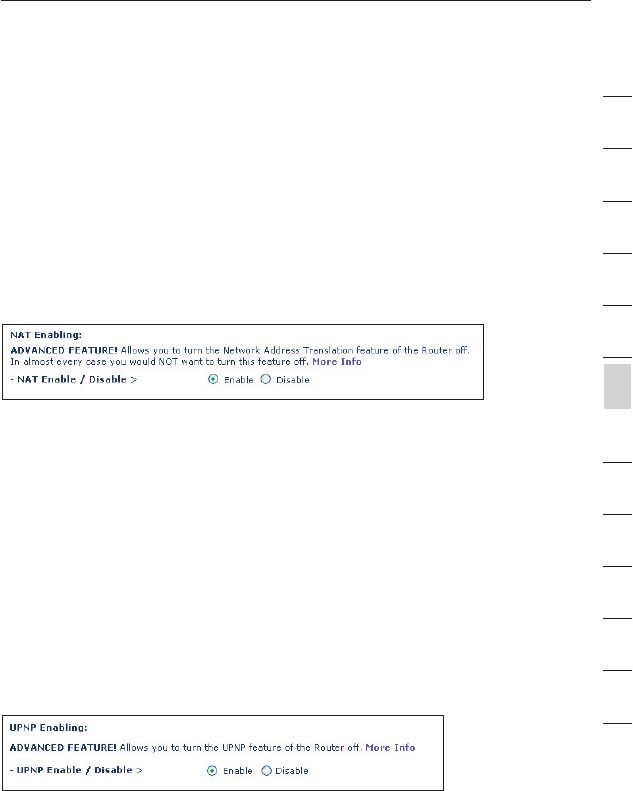
98
Using the Web-Based Advanced User Interface
Using the Web-Based Advanced User Interface
99
section
2
1
3
4
5
6
7
8
9
10
11
12
13
Enabling/Disabling NAT (Network Address Translation)
Note: This advanced feature should be employed by advanced users only.
Before enabling this function, MAKE SURE YOU HAVE SET THE
ADMINISTRATOR PASSWORD. Network Address Translation (NAT) is the
method by which the Router shares the single IP address assigned by your
ISP with the other computers on your network. This function should only be
used if your ISP assigns you multiple IP addresses or you need NAT disabled
for an advanced system configuration. If you have a single IP address and
you turn NAT off, the computers on your network will not be able to access
the Internet. Other problems may also occur. Turning off NAT will disable your
firewall functions.
Enabling/Disabling UPnP
UPnP (Universal Plug-and-Play) is yet another advanced feature offered by
your Belkin Router. It is a technology that offers seamless operation of voice
messaging, video messaging, games, and other applications that are UPnP-
compliant. Some applications require the Router’s firewall to be configured
in a specific way to operate properly. This usually requires opening TCP and
UDP ports, and in some instances, setting trigger ports. An application that
is UPnP-compliant has the ability to communicate with the Router, basically
“telling” the Router which way it needs the firewall configured. The Router
ships with the UPnP feature disabled. If you are using any applications that
are UPnP-compliant, and wish to take advantage of the UPnP features, you
can enable the UPnP feature. Simply select “Enable” in the “UPnP Enabling”
section of the “Utilities” page. Click “Apply Changes” to save the change.
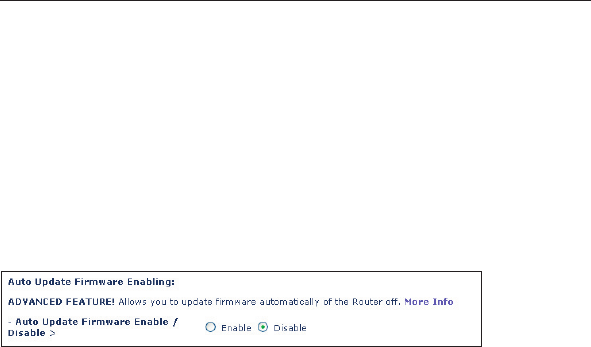
100
Using the Web-Based Advanced User Interface
Manually Configuring Computer Network Settings
101
section
2
1
3
4
5
6
7
8
9
10
11
12
13
Enabling/Disabling Auto Firmware Update
This innovation provides the Router with the built-in capability to
automatically check for a new version of firmware and alert you that the new
firmware is available. When you log into the Router’s advanced interface,
the Router will perform a check to see if new firmware is available. If so, you
will be notified. You can choose to download the new version or ignore it.
The Router ships with this feature enabled. If you want to disable it, select
“Disable” and click “Apply Changes”.
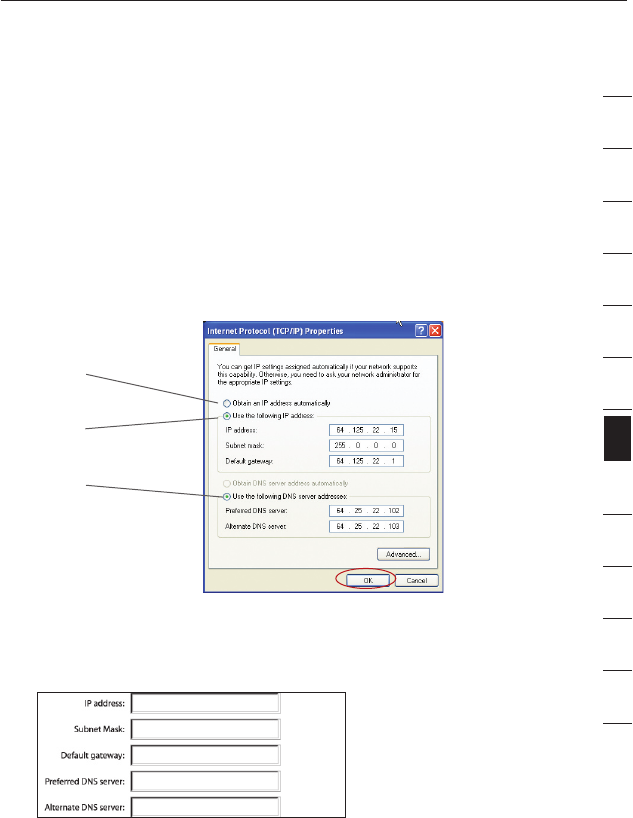
100
Using the Web-Based Advanced User Interface
Manually Configuring Computer Network Settings
101
section
2
1
3
4
5
6
7
8
9
10
11
12
13
In order for your computer to properly communicate with your Router, you will
need to change your PC’s TCP/IP settings to DHCP.
Manually Configuring Network Adapters in Windows 2000, NT, or XP
1. Click “Start”, “Settings”, then “Control Panel”.
2. Double-click on the “Network and dial-up connections” icon
(Windows 2000) or the “Network” icon (Windows XP).
3. Right-click on the “Local Area Connection” associated with your
network adapter and select “Properties” from the drop-down menu.
4. In the “Local Area Connection Properties” window, click “Internet
Protocol (TCP/IP)” and click the “Properties” button. The following
screen will appear:
5. If “Use the following IP address” (2) is selected, your Router will
need to be set up for a static IP connection type. Write the address
information the table below. You will need to enter this information
into the Router.
6. If not already selected, select “Obtain an IP address automatically”
(1) and “Obtain DNS server address automatically” (3). Click “OK”.
Your network adapter(s) are now configured for use with the Router.
(1)
(2)
(3)
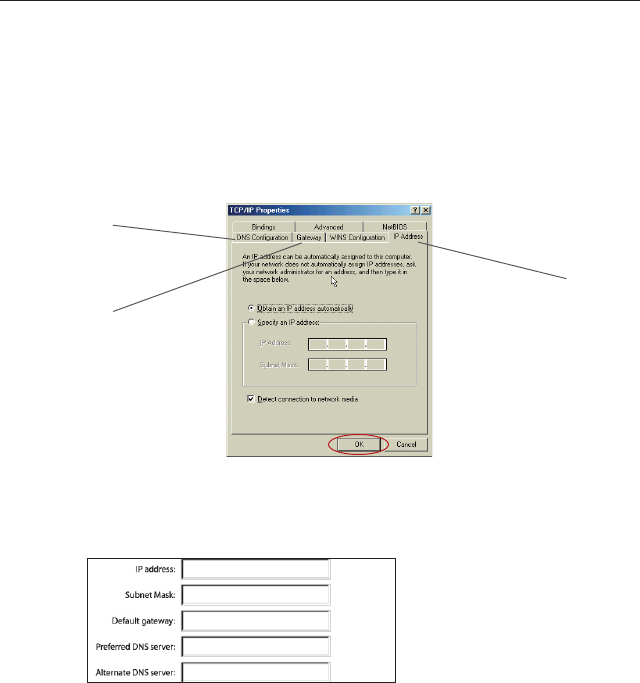
102
Manually Configuring Computer Network Settings
Manually Configuring Computer Network Settings
103
section
2
1
3
4
5
6
7
8
9
10
11
12
13
Manually Configuring Network Adapters in Windows 98SE or Me
1. Right-click on “My Network Neighborhood” and select
“Properties” from the drop-down menu.
2. Select “TCP/IP -> settings” for your installed network adapter.
You will see the following window.
3. If “Specify and IP address” is selected, your Router will need
to be set up for a static IP connection type. Write the address
information in the table below. You will need to enter this
information into the Router.
(1)
(2)
(3)
4. Write the IP address and subnet mask from the “IP Address”
tab (3).
5. Click the “Gateway” tab (2). Write the gateway address down in
the chart.
6. Click the “DNS Configuration” tab (1). Write the DNS address(es)
in the chart.
7. If not already selected, select “Obtain IP address automatically”
on the IP address tab. Click “OK”.
Restart the computer. When the computer restarts, your network
adapter(s) are now configured for use with the Router.
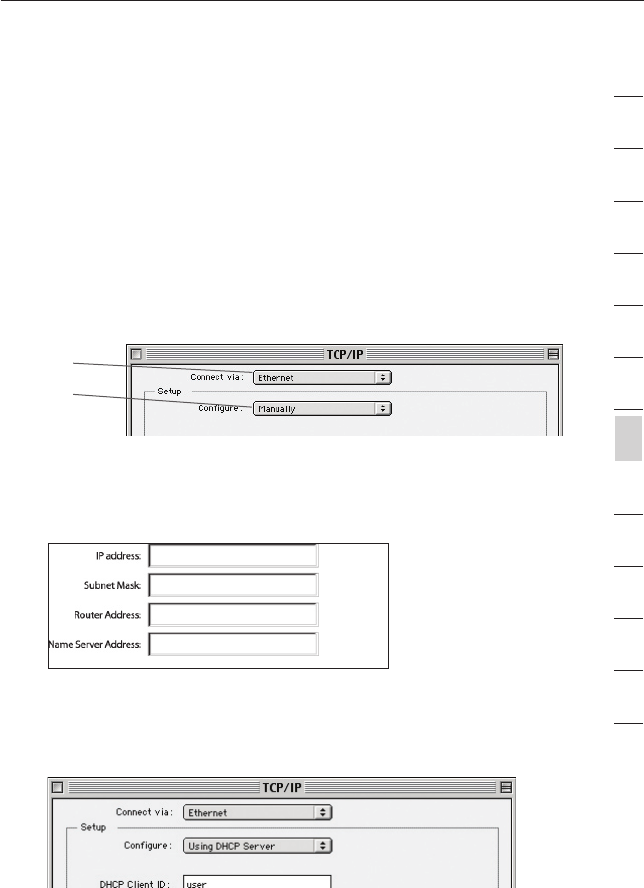
102
Manually Configuring Computer Network Settings
Manually Configuring Computer Network Settings
103
section
2
1
3
4
5
6
7
8
9
10
11
12
13
Set up the computer that is connected to the cable or DSL modem
FIRST using these steps. You can also use these steps to add
computers to your Router after the Router has been set up to connect
to the Internet.
Manually Configuring Network Adapters in Mac OS® up to 9.x
In order for your computer to properly communicate with your Router,
you will need to change your Mac’s TCP/IP settings to DHCP.
1. Pull down the Apple menu. Select “Control Panels” and
select “TCP/IP”.
2. You will see the TCP/IP control panel. Select “Ethernet Built-In”
or “Ethernet” in the “Connect via:” drop-down menu (1).
3. Next to “Configure” (2), if “Manually” is selected, your Router
will need to be set up for a static IP connection type. Write the
address information in the table below. You will need to enter this
information into the Router.
(1)
(2)
4. If not already set, at “Configure:”, choose “Using DHCP
Server”. This will tell the computer to obtain an IP address
from the Router.

104
Manually Configuring Computer Network Settings
Manually Configuring Computer Network Settings
105
section
2
1
3
4
5
6
7
8
9
10
11
12
13
5. Close the window. If you made any changes, the following
window will appear. Click “Save”.
Restart the computer. When the computer restarts, your network
settings are now configured for use with the Router.
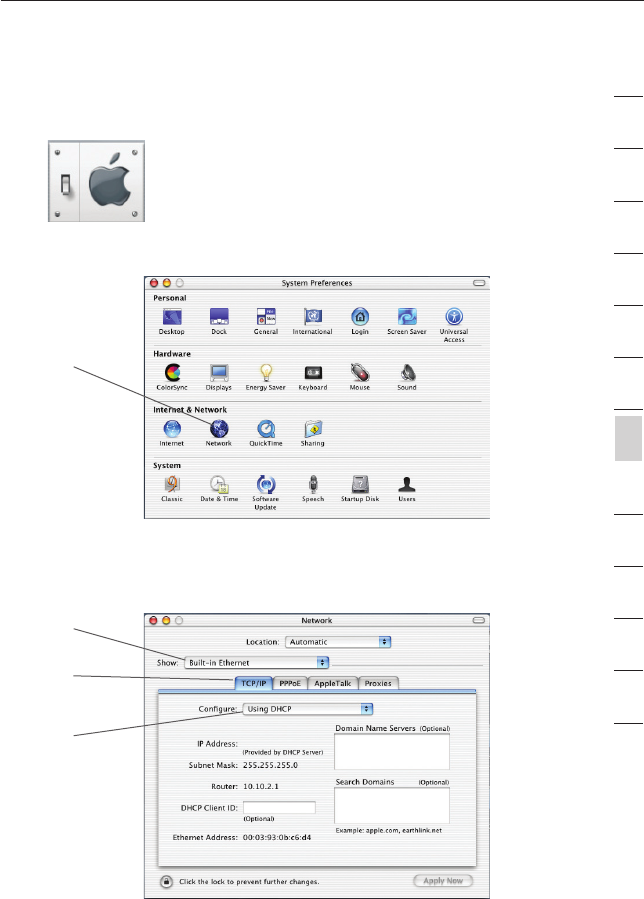
104
Manually Configuring Computer Network Settings
Manually Configuring Computer Network Settings
105
section
2
1
3
4
5
6
7
8
9
10
11
12
13
Manually Configuring Network Adapters in Mac OS X
1. Click on the “System Preferences” icon.
2. Select “Network” (1) from the “System Preferences” menu.
3. Select “Built-in Ethernet” (2) next to “Show” in the
Network menu.
(1)
(2)
(3)
(4)
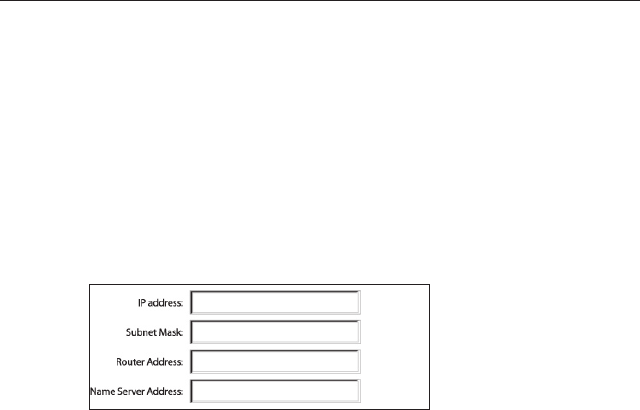
106
Manually Configuring Computer Network Settings
Recommended Web Browser Settings
107
section
2
1
3
4
5
6
7
8
9
10
11
12
13
4. Select the “TCP/IP” tab (3). Next to “Configure” (4), you should
see “Manually” or “Using DHCP”. If you do not, check the
PPPoE tab (5) to make sure that “Connect using PPPoE” is NOT
selected. If it is, you will need to configure your Router for a
PPPoE connection type using your user name and password.
5. If “Manually” is selected, your Router will need to be set up
for a static IP connection type. Write the address information
in the table below. You will need to enter this information into
the Router.
6. If not already selected, select “Using DHCP” next to “Configure”
(4), then click “Apply Now”.
Your network adapter(s) are now configured for use with the Router.